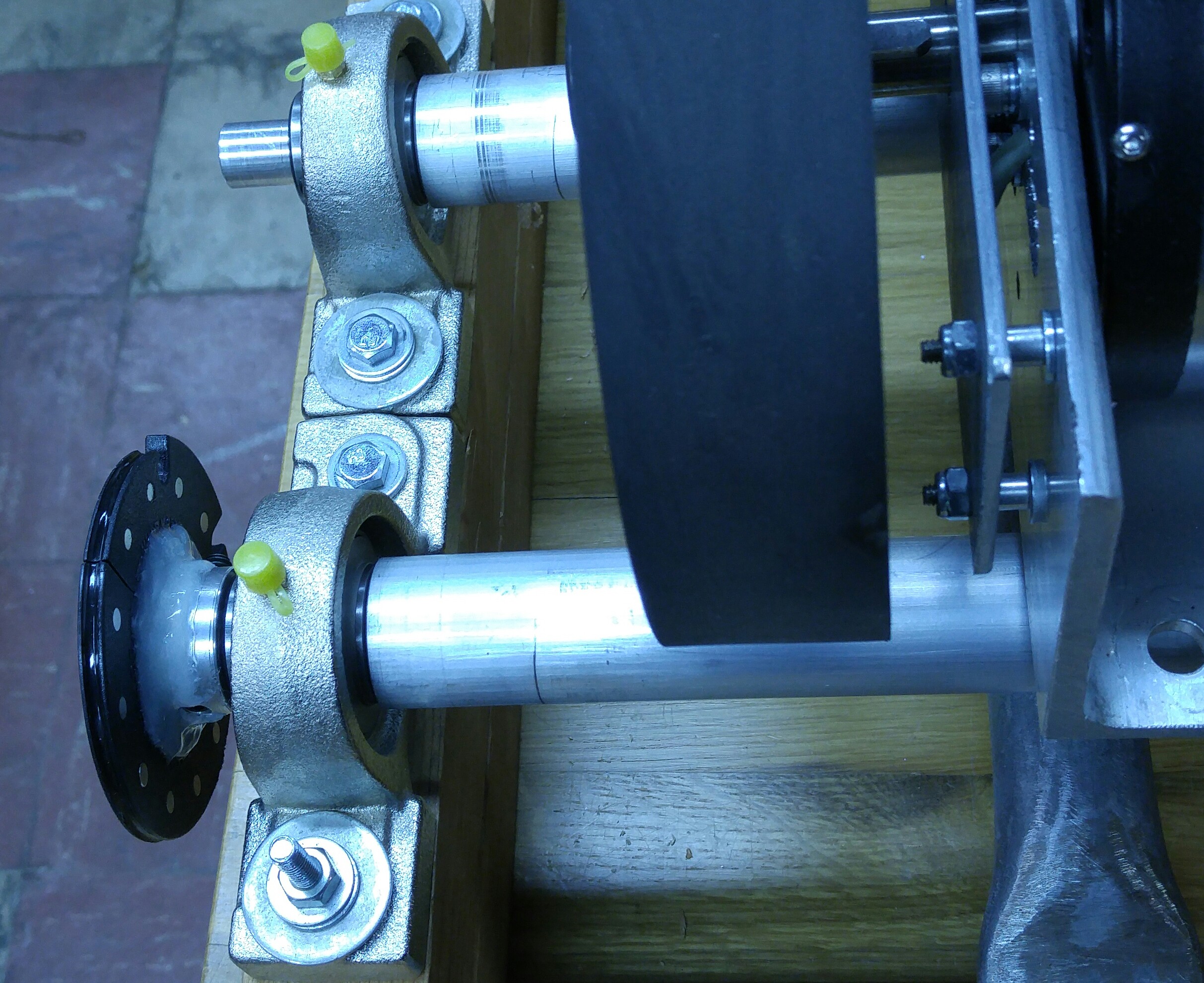This page's link: "erowbike.com/bogiedyno"
Return to Main Menu
Documentation for Custom Dynomometer to Test Performance of Electric Mobility Devices
The BogieDyno was developed specifically to test the performance of the "bogies" which power Bill James' JPods.
Related Links:
Controllers (3 phase BLDC)
Cycle Analyst (v3)
RPM Measurement
The JPods bogies use solid aluminum wheels with a rubber perimeter, resulting in an effective outside diameter of 8.0 inches.
The solid aluminum rollers used on the BogieDyno are 1.25 inches in diameter and use no covering.
The bogie wheels are directly fastened to the output motor shaft, and therefore rotate at the same RPM as the 3 phase brushless DC (BLDC) motor.
The motor uses internal Hall sensors which are monitored by a Cycle Analyst (v3) to provide an accurate RPM for the motor itself.
An 8" wheel rotating at 1,470 RPM would result in a bogie speed of 35 MPH, assuming no slippage on the surface on which it is traveling.
An 8" wheel rotating on a 1.25" roller at the above speed causes the roller to spin at a rate 6.4001 times faster, or 9,408.1 RPM at 35 MPH.
Using a sensor wheel with 12 magnets (poles), there will be 1,881.6 pulses per second transmitted to the Hall sensor. (0.532 ms/count)
For practical testing purposes, the rollers will be limited to a spinning speed of 10,000 (10K) RPM.
freq.README
Raspberry Pi used to calculate RPM and related data (speed)
The pigpio Library
On the Pi you are going to use as a test frequency generator, install the pigpio library as instructed on the page below.
I ran all the tests shown after the install with no errors on an A+ with 256Mb of ram.
I like to put downloaded source code in /usr/local/src so I can find it later. Start with cd /usr/local/src then follow the instructions
Download & Install abyz.co.uk/rpi/pigpio/download.html
All the things it can do are listed here: abyz.co.uk/rpi/pigpio/index.html
freq-gen-pigpio.py
Copy the script freq-gen-pigpio.py from wanda:/tmp/freq-gen-pigpio.py to /root/bin on the system that will be the frequency generator.
freq-counter.c [13 Feb 2016]
freq-counter2.py [2,725 13 Feb 2016 16:49]
If you don't have a /root/bin directory, create one. I like to keep all my scripts that I'm working on there.
I scp'd the python script to wanda:/tmp instead of just emailing it, so the Unix style line endings would be preserved.
You need to start the pigpiod daemon before you run the python script.
Edit the script Rpm = line for the frequency you want.
When you run it, the script will generate a square wave of the frequency defined by the number of magnets for 60 seconds, then the waveform stops.
When it starts, the script prints the values of Magnets, Rpm, Hz, and Period so you can see what it is generating.
It would be interesting to see how it looks on your digital scope, and what the scope measures the frequency as.
I adapted code from here to create freq-gen-pigpio.py.
http://raspberrypi.stackexchange.com/questions/19765/rpi-gpio-as-a-high-speed-square-wave-generator
I will be following up with the frequency counter script after I tweek the code a little. That will run on a different Pi, the one that will eventually be mounted on your dyno.
PiScope youtube video
King-Meter 12 magnet sensor wheel
A 12 magnet sensor wheel mounted on the dyno rollers feeds RPM data into the Raspberry Pi via a digital Hall Effect sensor which reads the changing magnetic fields from the rotating wheel.

Return to Top of Page
Return to Main Menu
